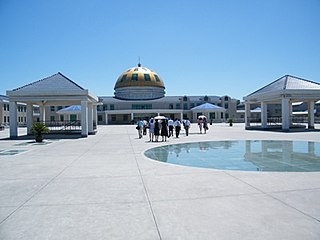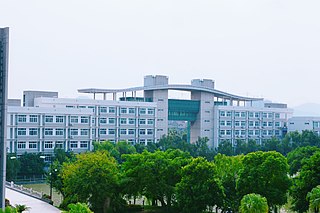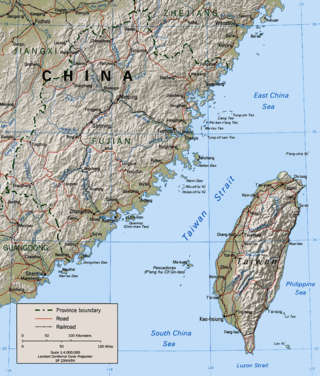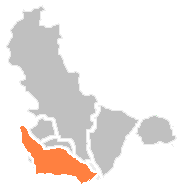
Fuzhou, alternately romanized as Foochow, is the capital and one of the largest cities in Fujian province, China. Fuzhou lies between the Min River estuary to the south and the city of Ningde to the north. Together, Fuzhou and Ningde make up the Mindong linguistic and cultural region.

Fuzhou University is a university located in Fuzhou, Fujian, China. Split into two campuses by the Min River, Fuzhou University's Old Campus is located on the north bank of the river in the western part of Fuzhou City, while the New Campus is located on the edge of the city on the south bank, at the base of Qi Mountain.

Beijing Foreign Studies University, is a public university in Beijing, China. BFSU boasts the oldest language programs in China offering the largest number of foreign language majors on different educational levels. Located in Haidian District of Beijing BFSU is divided into east and west campuses. BFSU offers the widest range of language studies in China: as of September 2019, there are 101 foreign languages being taught in this university. It is a Chinese state Double First Class University identified by Chinese Ministry of Education. BFSU is commonly known as Beiwai in Mandarin. Beijing Foreign Studies University is a sister school to Peking University (PKU) which is also subordinate to the Ministry of Education. For this reason BFSU students are able to register for courses at PKU.

Shanghai International Studies University is China's leading university in linguistics, cultural studies, and global and area studies. Established in December 1949, SISU is known for being one of the earliest institutions where China's higher education in foreign languages took shape. It was listed in the Double First Class University identified by the Ministry of Education and former Project 211.

The Fuzhou language, also Foochow, Hokchew, Hok-chiu, or Fuzhounese, is the prestige variety of the Eastern Min branch of Min Chinese spoken mainly in the Mindong region of Eastern Fujian Province. As it is mutually unintelligible to neighbouring varieties in the province, under a technical linguistic definition Fuzhou is a language and not a dialect. Thus, while Fuzhou may be commonly referred to as a 'dialect' by laypersons, this is colloquial usage and not recognised in academic linguistics. Like many other varieties of Chinese, the Fuzhou dialect is dominated by monosyllabic morphemes that carry lexical tones, and has a mainly analytic syntax. While the Eastern Min branch it belongs to is relatively closer to other branches of Min such as Southern Min or Pu-Xian Min than to other Sinitic branches such as Mandarin, Wu Chinese or Hakka, they are still not mutually intelligible.

Futian District is one of the nine districts comprising the city of Shenzhen, China. The district is home to the government and Municipal Committee of Shenzhen, as well as the city's central business district (CBD).

Changle (help·info) is one of 6 urban districts of the prefecture-level city of Fuzhou, the capital of Fujian Province, China. It occupies a land area of 648 square kilometers (250 sq mi) and a sea area of 1,327 square kilometers (512 sq mi). Changle was established in the sixth year of Emperor Wude during the Tang dynasty, and it became a county-level city on February 18, 1994. The district faces the East China Sea and is connected to Mawei district by the Min River. Due to an increase in businesses, the province is now one of the richest provinces in China. The city was upgraded to a district in August 2017 by a government proposal.

Cangshan District is one of 6 urban districts of the prefecture-level city of Fuzhou, the capital of Fujian Province, China.

William Sandford Pakenham-Walsh was a Christian clergyman, educationalist and writer. He was most famous for his work Tudor Story.

Suzhou High School, officially the Suzhou High School of Jiangsu Province, is a Chinese public high school of one-millennium rich history, located in Suzhou, Jiangsu. In AD 1035, the Northern Song politician and writer Fan Zhongyan founded the predecessor of Suzhou High school, Suzhou Prefecture School (苏州府学).
Japanese people in China are Japanese expatriates and emigrants and their descendants residing in Greater China. In October 2018, there were 171,763 Japanese nationals living in the People's Republic of China, and 24,280 Japanese nationals living in the Republic of China (Taiwan).

Northern Min is a group of mutually intelligible Min varieties spoken in Nanping prefecture of northwestern Fujian.

Jinan Foreign Language School is a foreign language school located in Jinan, China, and is divided into three branches/levels: the junior, senior, and primary branches. The school is the only one of its kind officially registered with the State Education Ministry of Shandong Province. It is also the school which sends the largest number of admitted-by-recommendation students toward Chinese priority colleges and universities among all Chinese high schools. In a 2016 ranking of Chinese high schools that send students to study in American universities, Jinan Foreign Language School ranked number 42 in mainland China in terms of the number of students entering top American universities.

The Zhejiang Wenzhou High School, known colloquially as Wenyizhong (WZHS), is a public senior high school located in Wenzhou, Zhejiang, China. WZHS is situated in the Ouhai District of Wenzhou, within the Sanyang Wetland Scenic Area. It is one of the first provincial first-class high schools and first provincial first-class ordinary high school model schools established by the Department of Education of Zhejiang Province. Wenzhou High School is known as the "cradle of mathematicians" for educating many famous mathematicians, such as Su Buqing and Gu Chaohao. Among the best schools in China in 2015, Zhejiang Wenzhou High School is ranked 46.
Shehua is an unclassified Sinitic language spoken by the She people of Southeastern China. It is also called Shanha, San-hak (山哈) or Shanhahua (山哈话). Shehua speakers are located mainly in Fujian and Zhejiang provinces of Southeastern China, with smaller numbers of speakers in a few locations of Jiangxi, Guangdong and Anhui provinces.

The Fuzhou Confucian Temple, more commonly known as Xianshi Temple (先師廟) or Temple of Saints (聖人殿), is a Confucian temple located in Fuzhou, Fujian.

The Fujian–Taiwan relations, also known as the Min–Tai relations, refers to the relationship between Fujian, which is located in mainland China, and Taiwan, which is across the Taiwan Strait. Since the average width of the Taiwan Strait is 180 kilometers, Fujian and Taiwan are adjacent, similar in both climate and environment. Although the relationship between Taiwan and Fujian has changed with the development of history, the two places have maintained close relations in terms of personnel, economy, military, culture and other aspects. At present, Taiwan residents are mostly descendants of immigrants from mainland China, of which the southern Fujian ethnic group is the main group, accounting for 73.5% of Taiwan's total population. In terms of culture, language, religion, and customs, Fujian and Taiwan also share similarities.

Nantai is the largest island in the Min River of Fujian. It is located in the center of the Fuzhou Plain, surrounded by the "north harbor" of the Min (闽江北港) and the Wulong River, or "south harbor" of the Min. It has the nickname "Island of Chinese snowballs and jade" (琼花玉岛).


















